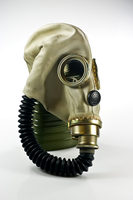








The gas mask is a mask used to protect the user from inhaling airborne pollutants and toxic gases. The mask forms a sealed cover over the nose and mouth, but may also cover the eyes and other vulnerable soft tissues of the face. Some gas masks are also respirators, though the word gas mask is often used to refer to military equipment (e.g. Field Protective Mask). The user of the gas mask is not protected from gas that the skin can absorb. Most gas mask filters will last around 24 hours in an NBC (nuclear biological chemical) situation.
Activated charcoal is a common component of gas masks. It is a form of carbon with an extremely high surface area which attracts all manner of pollutants from air and water. Pollutants do not react with the carbon but are adsorbed into the pores. Over time the activated carbon becomes thoroughly coated and it ceases to remove pollutants. However, the charcoal can be reactivated and restored to its original state by baking the charcoal with high heat, which evaporates or burns off the pollutants.
The first effective filtering activated charcoal gas mask in the world invented in 1915 by Russian chemist Nikolay Zelinsky.
In the first gas masks of World War I, it was initially found that wood charcoal was a good absorbent of poison gases. In about 1918, it was found that charcoals made from the shells and seeds of various fruits and nuts such as coconuts, chestnuts, horse-chestnuts, and peach stones performed much better than wood charcoal. These waste materials were collected from the public in recycling programs to assist the war effort.